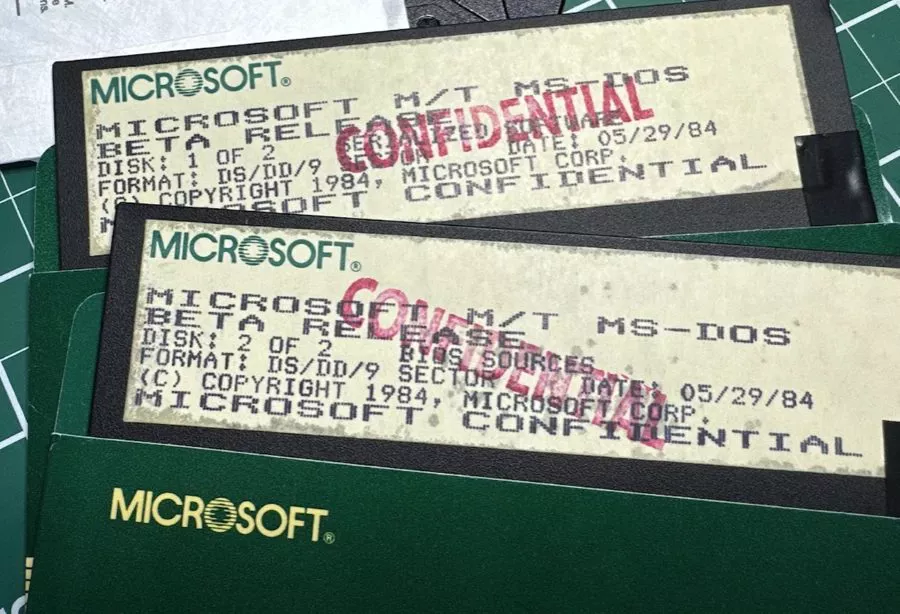Microsoft has been moving towards the open source philosophy for years: the source code of many of its products is now publicly available. The Azure platform has also strengthened the link with the Linux platform and with open projects, which have become an essential element in growing the business of the Redmond company and its customers. Richard Stallman (FSF, Free Software Foundation) has asked several times, often provocatively, to release the Windows sourceat least the one relating to systems no longer supported by Microsoft.
For now, Microsoft is just releasing MS-DOS 4.0 as a product open source, 38 years after its publication. It’s very little, because MS-DOS is now an outdated operating system, which has made history Compatible IBM PCs. However, it is still news of great historical importance.
How to download the MS-DOS 4.0 source code
Scott Hanselman and Jeff Wilcox made the announcement: starting today on GitHub you can find and download the source code, binary files, disk images and documentation. The source, after so many years, is now distributed below MIT license, offering interested parties ample room for maneuver. In another article we clarified the differences between open source and free software, addressing the delicate issue of software licenses.
In the note that appeared on the Microsoft blog, Hanselman and Wilcox explain that the publication of the MS-DOS 4.0 source is largely the result of the collaboration established between the former Chief Technical Officer of Microsoft Ray Ozzie and a young computer researcher called Connor ‘Starfrost’ Hyde.
The history of MS-DOS, in brief
MS-DOS (Microsoft Disk Operating System) is one of the most iconic operating systems in the history of computing. There history of MS-DOS began in the early 1970s when the Microsoft Corporation, founded by Bill Gates and Paul Allen, obtained a contract to develop a interprete BASIC for one of the first microcomputers to appear on the market, the Altair 8800. This experience laid the foundation for the company’s future ambitions in the field of operating systems.
In 1980, IBM he was looking for an operating system for his project personal computer. Microsoft, without an operating system of its own to offer, decided to acquire a simplified version of CP/M (Control Program for Microcomputers) from Digital Research. To close the deal with Digital Research, Microsoft took care to acquire a license for an operating system called QDOS (Quick and Dirty Operating System) sviluppato da Tim Paterson (Seattle Computer Products).
QDOS was based in part on CP/M and was designed to run on Intel 8086/8088 processors. After acquiring the rights to use QDOS, Microsoft renamed it MS-DOS in 1981 and supplied it to IBM for its PC. In 1983, MS-DOS formed the basis for the operation of PC-DOS 2.0the version of the operating system intended for IBM systems and in particular for the successful IBM PC-XT of 1983 which truly opened the era of personal computing.
With a diagram of licensing truly innovative for its time, Microsoft asked IBM to pay 3 dollars for each installation of PC-DOS. The choice was very good, so much so that in 1983 Microsoft already had a turnover of 100 million dollars.
The innovation of MS-DOS
With its text-based interface, MS-DOS quickly became the standard in fact by and PC IBM and compatible personal computers. Its popularity grew further with the release of version 2.0 in 1983, which introduced the concept of file system FAT (File Allocation Table) and improved memory management.
The initial announcement of MS-DOS 4.0 dates back to May 1986. The operating system introduced support for larger hard drives, allowing users to manage and access larger-capacity hard drives and floppy disks.
One of the most significant features of MS-DOS 4.0 was the ability to compress files to save disk space. This feature allowed users to store more data on their storage drives, helping to more efficiently manage available space and improve overall system performance.
The platform included better support for extended memory (EMS): This allowed users to take advantage of memory above the 640 KB traditionally available in 16-bit systems, allowing more complex and heavy applications to run.
However, the release of MS-DOS 4.0 was not free from criticism: many had detected stability problems and several bugs that Microsoft developers had not detected in the testing phase and which had reached the final release.
The concept of multitasking
Although somewhat limited, MS-DOS 4.0 also introduced some features multitasking which allowed multiple programs to run simultaneously. Hyde analyzed precisely this aspect, arguing how it formed the foundations of IBM OS/2.
One of the key components was the session manager (SM.EXE). Hyde explains that this element allowed quick switching between up to six predefined applications. However, the system had several bugs and was not yet mature.
More information on the details relating to the operation of MS-DOS 4.0 can be found in these pages.
Opening image credit: Microsoft.

